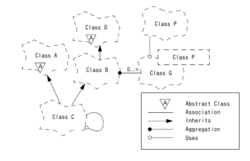
The Booch method[1] is a method for object-oriented software development. It is composed of an object modeling language,[2] an iterative object-oriented development process,[3] and a set of recommended practices.[4]
The method was authored by Grady Booch when he was working for Rational Software (acquired by IBM), published in 1992 and revised in 1994. It was widely used in software engineering for object-oriented analysis and design and benefited from ample documentation and support tools.[5]
The notation aspect of the Booch methodology was superseded by the Unified Modeling Language (UML), which features graphical elements from the Booch method along with elements from the object-modeling technique (OMT) and object-oriented software engineering (OOSE). Methodological aspects of the Booch method have been incorporated into several methodologies and processes, the primary such methodology being the Rational Unified Process (RUP).[citation needed]
YouTube Encyclopedic
-
1/3Views:1 49257 42014 474
-
methodologies
-
27 - OOAD - I
-
29 - OOAD - III
Transcription
Content of the method
The Booch notation is characterized by cloud shapes to represent classes and distinguishes the following diagrams:[6]
| Model | Type | Diagram | UML correspondence |
|---|---|---|---|
| Logical | Static | Class diagram | Class diagram |
| Object diagram | Object diagram | ||
| Dynamic | State transition diagram | State chart diagram | |
| Interaction diagram | Sequence diagram | ||
| Physical | Static | Module diagram | Component diagram |
| Process diagram | Deployment diagram |
The process is organized around a macro and a micro process.[1]
The macro process identifies the following activities cycle:
- Conceptualization : establish core requirements
- Analysis : develop a model of the desired behavior
- Design : create an architecture
- Evolution: for the implementation
- Maintenance : for evolution after the delivery
The micro process is applied to new classes, structures or behaviors that emerge during the macro process. It is made of the following cycle:
- Identification of classes and objects
- Identification of their semantics
- Identification of their relationships
- Specification of their interfaces and implementation
References
- ^ a b Booch, Grady (1993). Object-oriented Analysis and Design with Applications (2nd ed.). Redwood City: Benjamin Cummings. ISBN 0-8053-5340-2.
- ^ Booch, Grady (1994). "Chapter 5:Notation". Object-Oriented Analysis and Design with Applications (2nd Edition). Addison-Wesley. ISBN 0-8053-5340-2.
- ^ Booch, Grady (1994). "Chapter 6:The process". Object-Oriented Analysis and Design with Applications (2nd Edition). Addison-Wesley. ISBN 0-8053-5340-2.
- ^ Booch, Grady (1994). "Chapter 7:Pragmatics". Object-Oriented Analysis and Design with Applications (2nd Edition). Addison-Wesley. ISBN 0-8053-5340-2.
- ^ Martin, Robert Cecil (1995). Designing Object-Oriented C++ Applications using the Booch Method. Prentice-Hall. ISBN 0-13-203837-4.
- ^ MD, Fathima. "World of diagrams:Booch diagrams". Retrieved 3 January 2017.
External links
- Class diagrams, Object diagrams, State Event diagrams and Module diagrams.
- The Booch Method of Object-Oriented Analysis & Design
